
Copyright 2001, 2006, 2011 by Ray Foley
Cover and internal design 2011 by Sourcebooks, Inc.
Cover design by Krista Joy Johnson/Sourcebooks
Cover and internal illustration by Krista Joy Johnson/Sourcebooks Sourcebooks and the colophon are registered trademarks of Sourcebooks, Inc. All rights reserved. No part of this book may be reproduced in any form or by any electronic or mechanical means including information storage and retrieval systemsexcept in the case of brief quotations embodied in critical articles or reviewswithout permission in writing from its publisher, Sourcebooks, Inc. This publication is designed to provide accurate and authoritative information in regard to the subject matter covered. It is sold with the understanding that the publisher is not engaged in rendering legal, accounting, or other professional service. If legal advice or other expert assistance is required, the services of a competent professional person should be sought.
From a Declaration of Principles Jointly Adopted by a Committee of the American Bar Association and a Committee of Publishers and Associations All brand names and product names used in this book are trademarks, registered trademarks, or trade names of their respective holders.
Sourcebooks, Inc., is not associated with any product or vendor in this book. The author and Sourcebooks, Inc. shall have neither liability nor responsibility to any person or entity with respect to any loss, damage, or injury caused or alleged to be caused directly or indirectly by the information in this book. Published by Sourcebooks, Inc.
P.O. Box 4410, Naperville, Illinois 60567-4410
(630) 961-3900
Fax: (630) 961-2168
www.sourcebooks.com Originally published in 2001 The Library of Congress has catalogued the second edition as follows: Foley, Ray. p. cm. cm.
Includes index. 1. Cocktails. 2. Alcoholic beverages. 3.
Blenders (Cookery). I. Title.
TX951.F5949 2006
641.874dc22 2005025116
This book is dedicated to all the blended cocktail drinkers and bartenders who stir, shake, and serve.
Also to Jaclyn Marie and Ryan Foley and the rest of the tribe!

ACKNOWLEDGMENTS
Bacardi USA, Inc. Barton Incorporated Brown-Forman Beverages Worldwide Coco Lopez, Inc.Jose Suarez, R. Jake Jacobsen Imperial Brands, Inc. (Angostura Rum)Peter Schwartz, Dave Conroy Jim Beam Brands Worldwide, Inc. (Angostura Rum)Peter Schwartz, Dave Conroy Jim Beam Brands Worldwide, Inc.
McCormick DistillingVic Morrison, Doc Sullivan National Cherry BoardCheryl Kroupa Rmy Amerique SKYY Spirits, LLC.Gerry Ruvo Vita-Mix CorporationRula Stamatis Waring Products Special thanks to Jimmy Zazzali, Laura Keegan, Matt Wojciak, John Cowan, Lauren Saccone, Michael Cammarano, and Marvin Solomon. In addition, to all those who submitted recipes to www.bartender.com and the readers of Bartender Magazine. 
INTRODUCTION
All recipes have been alphabetized for your convenience.
Techniques of Mixing
1. BlendAll, yes all, cocktails are to be blended with ice. 2. 2.
GlassesYou should use your imagination on choice of glassware. This will add your personal signature to each cocktail. Any type of drinking vessel is permitted. Let your creativity pour wild. 3. IngredientsPlease only use the BEST ingredientsthe top of the line.
You would not buy cheap meat when cooking a steak. Use top brandsthey make top cocktails. 4. Have Fun!  All recipes with this icon have been submitted by one of Americas top bartenders. Enjoy! Publishers Note: This book and the recipes contained herein are intended for those of a legal drinking age. Please drink responsibly and ensure that you and your guests have a designated driver when consuming alcoholic beverages.
All recipes with this icon have been submitted by one of Americas top bartenders. Enjoy! Publishers Note: This book and the recipes contained herein are intended for those of a legal drinking age. Please drink responsibly and ensure that you and your guests have a designated driver when consuming alcoholic beverages.
Raw Egg Warning: Some recipes contained in this book call for the use of raw eggs. The Food and Drug Administration advises caution in consuming raw and lightly cooked eggs, due to the slight risk of salmonella or other food-borne illness. To reduce this risk, the FDA recommends that you use only fresh, clean, properly refrigerated and pasteurized eggs with intact shells. Always wash hands, cooking utensils, equipment, and work surfaces with warm, soapy water before and after they come in contact with eggs.
Short History of the Blender
Waring, universally known for introducing the first blender to American consumers, is one of todays leading manufacturers of professional-quality, small appliances for the home, food-service, and laboratory industries. The company was acquired on May 9, 1998, by Conair Corporation, which also owns Cuisinart.
Although the company is named after Fred Waring, a popular entertainer of the 1930s, 40s, and 50s, Waring did not actually invent the blender. He did, however, perfect the original version and introduce this version to retailers and consumerswhich ultimately became a big success. Waring history has it that in 1936, Fred Waring had just finished a radio broadcast in New Yorks Vanderbilt Theater when Fred Osius, dressed in outlandish striped pants, a cutaway coat, and a bright lemon-yellow tie, approached the entertainer with his latest invention. Osius was looking for someone to finance a new mixer that would revolutionize peoples eating habits. Waring was intrigued with the concept of a mixer such as the one Osius described, and he agreed to back the new product, even when the prototype failed to work the first time. Six months and $25,000 later, the prototype still didnt work.
However, Waring remained enthusiastic and with his support the engineering and production problems were solved in time to introduce the new Miracle Mixer (as it was then called) at the National Restaurant Show in Chicago in 1937. Thanks to Warings own promotion of the blender on the radio and through a singing group aptly named The Waring Blendors, the blender became a permanent fixture in restaurants and bars. It wasnt long before consumers decided that they needed blenders in their kitchens as well. Ultimately, department- and specialty-store sales increased, and the blender became a household appliance for home chefs. World War II temporarily halted blender production, but in 1946, sales took off again as consumer demand grew. Product innovations continued, with the introduction of color-coordinated blenders and attachments that crushed ice and ground coffee.
Solid-state controls were among the most significant product changes. In the 1950s, new uses for the blender were constantly emerging, including applications in research laboratories. In fact, Dr. Jonas Salk used a Waring blender with an Aseptic Dispersal Container attachment to develop his lifesaving polio vaccine. During the late 1960s, design and engineering breakthroughs by Waring led to the creation of a more versatile blender that was more efficient and widely affordable. While maintaining its leadership in the blender market, Waring capitalized on its strong brand recognition and expanded its product line with a broad range of fine-quality kitchen appliances.
Fred Waring died in 1984, but his vision for a top-quality blender lives on as Waring continues to manufacture an innovative line of top-performance blenders for the home and for commercial use.

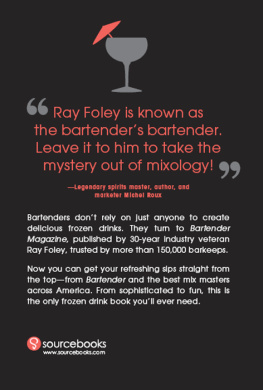

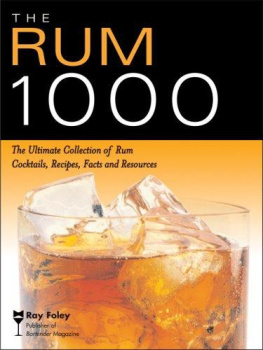
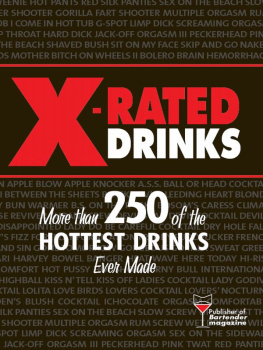
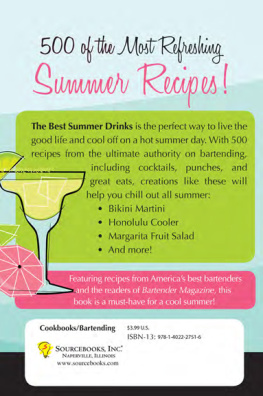

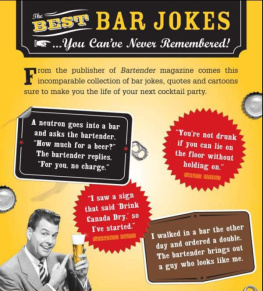


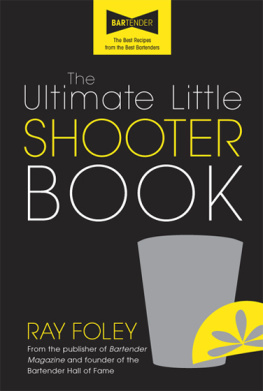


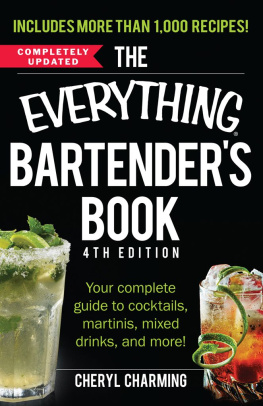


 Copyright 2001, 2006, 2011 by Ray Foley
Copyright 2001, 2006, 2011 by Ray Foley
 All recipes with this icon have been submitted by one of Americas top bartenders. Enjoy! Publishers Note: This book and the recipes contained herein are intended for those of a legal drinking age. Please drink responsibly and ensure that you and your guests have a designated driver when consuming alcoholic beverages.
All recipes with this icon have been submitted by one of Americas top bartenders. Enjoy! Publishers Note: This book and the recipes contained herein are intended for those of a legal drinking age. Please drink responsibly and ensure that you and your guests have a designated driver when consuming alcoholic beverages.